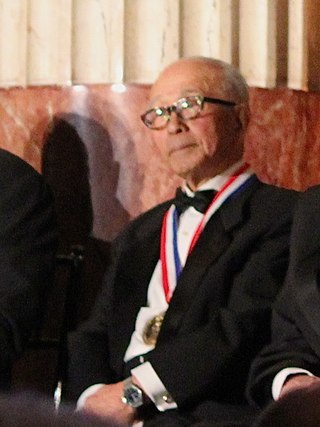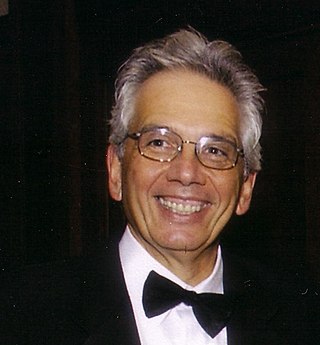
Nokia Bell Labs, originally named Bell Telephone Laboratories (1925–1984), then AT&T Bell Laboratories (1984–1996) and Bell Labs Innovations (1996–2007), is an American industrial research and scientific development company owned by Finnish company Nokia. It is headquartered in Murray Hill, New Jersey, and operates a global network of laboratories.

The U.S. National Academy of Engineering annually awards the Draper Prize, which is given for the advancement of engineering and the education of the public about engineering. It is one of three prizes that constitute the "Nobel Prizes of Engineering"—the others are the Academy's Russ and Gordon Prizes. The Draper Prize is awarded biennially and the winner of each of these prizes receives $500,000. The Draper prize is named for Charles Stark Draper, the "father of inertial navigation", an MIT professor and founder of Draper Laboratory.

Wireless communication is the transfer of information (telecommunication) between two or more points without the use of an electrical conductor, optical fiber or other continuous guided medium for the transfer. The most common wireless technologies use radio waves. With radio waves, intended distances can be short, such as a few meters for Bluetooth or as far as millions of kilometers for deep-space radio communications. It encompasses various types of fixed, mobile, and portable applications, including two-way radios, cellular telephones, personal digital assistants (PDAs), and wireless networking. Other examples of applications of radio wireless technology include GPS units, garage door openers, wireless computer mouse, keyboards and headsets, headphones, radio receivers, satellite television, broadcast television and cordless telephones. Somewhat less common methods of achieving wireless communications involve other electromagnetic phenomena, such as light and magnetic or electric fields, or the use of sound.

A cellular network or mobile network is a telecommunications network where the link to and from end nodes is wireless and the network is distributed over land areas called cells, each served by at least one fixed-location transceiver. These base stations provide the cell with the network coverage which can be used for transmission of voice, data, and other types of content. A cell typically uses a different set of frequencies from neighboring cells, to avoid interference and provide guaranteed service quality within each cell.

The history of mobile phones covers mobile communication devices that connect wirelessly to the public switched telephone network.
A mobile phone operator, wireless provider, or carrier is a mobile telecommunications company that provides wireless Internet GSM services for mobile device users. The operator gives a SIM card to the customer who inserts it into the mobile device to gain access to the service.

Martin Cooper is an American engineer. He is a pioneer in the wireless communications industry, especially in radio spectrum management, with eleven patents in the field.
Donald C. Cox is an American electrical engineer researching wireless communication, currently a professor at University of Nebraska-Lincoln, where he heads the Wireless Communications Research Group. His work on multipath and other propagation problems has been fundamental to the development of mobile phone technology.
Amos Edward Joel Jr. was an American electrical engineer, known for several contributions and over seventy patents related to telecommunications switching systems.

William Rae Young, Jr. was one of the Bell Labs engineers that invented the cell phone.
Jesse Eugene Russell is an American inventor. He was trained as an electrical engineer at Tennessee State University and Stanford University, and worked in the field of wireless communication for over 20 years. He holds patents and continues to invent and innovate in the emerging area of next generation broadband wireless networks, technologies and services, often referred to as 4G. Russell was inducted into the US National Academy of Engineering for his contributions to the field of wireless communication. He pioneered the field of digital cellular communication in the 1980s through the use of high power linear amplification and low bit rate voice encoding technologies and received a patent in 1992 for his work in the area of digital cellular base station design.

Richard H. Frenkiel is an American engineer, known for his significant role in the early development of cellular telephone networks.
Philip Thomas Porter was an electrical engineer and one of the guiding pioneers of the invention and development of early cellular telephone networks.

Yoshihisa Okumura was a Japanese engineer, known for development of cellular telephone networks. His radio survey of signal strength as a function of distance as measured in drive tests in automobiles was critical to the system planning of mobile radio telephone systems.
Thomas Haug was a Norwegian-Swedish electrical engineer known for developing the cellular telephone networks.
Theodore (Ted) Scott Rappaport is an American electrical engineer and the David Lee/Ernst Weber Professor of Electrical and Computer Engineering at New York University Tandon School of Engineering and founding director of NYU WIRELESS.

Richard D. Gitlin is an electrical engineer, inventor, research executive, and academic whose principal places of employment were Bell Labs and the University of South Florida (USF). He is known for his work on digital subscriber line (DSL), multi-code CDMA, and smart MIMO antenna technology all while at Bell Labs.
Sundeep Rangan is an associate professor at the New York University Tandon School of Engineering, where he also serves as the director of NYU Wireless. He was named Fellow of the Institute of Electrical and Electronics Engineers (IEEE) in 2016 for contributions to orthogonal frequency division multiple access cellular communication systems. Dr. Rangan received his B.A.Sc. at the University of Waterloo, Canada and the M.Sc. and Ph.D. at the University of California, Berkeley, all in Electrical Engineering. He has held postdoctoral appointments at the University of Michigan, Ann Arbor and Bell Labs. In 2000, he co-founded Flarion Technologies, a spin off of Bell Labs, that developed Flash OFDM, the first cellular OFDM data system and precursor to 4G cellular systems including LTE and WiMAX. In 2006, Flarion was acquired by Qualcomm Technologies. Dr. Rangan was a Director of Engineering at Qualcomm involved in OFDM infrastructure products. He joined the ECE department at NYU Tandon in 2010. His research interests are in wireless communications, signal processing, information theory and control theory.
Takuro Sato from Waseda University. He received the B.E. and Ph.D. degrees in electronics engineering from Niigata University. He was a member of Research and Development Laboratories, Oki Electric Industry Co., Ltd., in Tokyo, Japan, where he worked on PCM transmission equipment, mobile telephone and standardization of mobile data transmission and CDMA system for international standardization committee.
Nambirajan Seshadri is a professor of practice at the Department of Electrical and Computer Engineering, Jacobs School of Engineering, University of California, San Diego.









